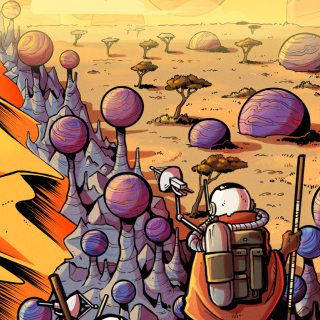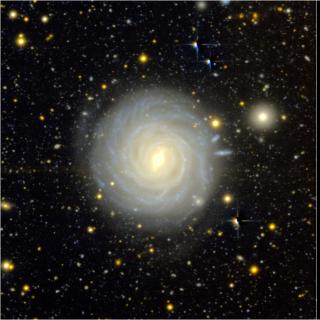His interest about the radiative transfer began in a lecture about "Stellar Atmospheres" he attended when he was studying his Physics degree. He was previously interested in particle physics but he liked the approach of quantitative spectroscopy which connects theory and observations and he wrote his Diploma thesis on radiative transfer in expanding atmospheres. Nowadays, Jo(achim) Puls is professor and researcher in the Universitätssternwarte der LMU München, where he works with his team investigating about radiative transfer in early-type stars and related problems, with many international collaborations like the one with the IAC team. Hes is one of the teachers of the XXIX Canary Islands Winter School of Astrophysics organized by the Instituto de Astrofísica de Canarias in collaboration with the Universidad de La Laguna (ULL).
"A specific photon generated in the center of a star will never reach the stellar surface".
"As with any new generation of telescopes, also the upcoming 30-m class will collect more photons than previous ones, and this is always good."
Question: What happens to a photon since it is generated in the center of the star until it can reach the surface so that we can see it?
Answer: Actually, this question is somewhat misleading. Indeed, a specific photon generated in the center of a star will never (or, more correctly, with an incredibly low probability) reach the stellar surface, and then escape from the star. What really happens is that the generated photons are, on their way out, scattered and absorbed due to different processes (in dependence of the local physical conditions), other photons are (re-)emitted, and so on, until the observed photons (which to a major part are created just in the uppermost layers) leave the star.
Since the temperature decreases strongly from the stellar center (millions of Kelvin) to the outermost layers (thousands of Kelvin), the original photons which have an energy distribution peaking in the X-ray regime will be degraded (by subsequent absorption and emission processes) to wavelengths peaking in the optical. The delicate interplay between absorption, emission and scattering on the one side and the stratification of the physical quantities such as temperature on the other constitutes an important aspect of radiative transfer. As an example, photon absorption usually heats the stellar plasma, the emission of photons cools it, and scattering leaves it roughly unchanged, while the temperature of the plasma controls which photons will be actually absorbed, and which will be emitted. One has to add, however, that in the outermost regions (the so-called photospheres) of early-type stars (surface temperatures of more than 10,000 K), the influence of the temperature becomes less important. In these photospheres, it is mostly the radiation field itself which directly controls the absorption and emission probabilities, by controlling the population of the absorbing and emitting electronic levels. This process makes corresponding calculations even more complex. Finally, I like to note that the energy distribution of the "observed" photons depends only on the physical structure of the photosphere, and not on the conditions in the stellar interior. Of course, the structure of the photosphere is strongly coupled with the internal conditions, and thus, indirectly, with the radiation field in the interior.
Q. What are the challenges of actual models? What are the challenges of the observations?
A: Here we have to distinguish between atmospheric and stellar models. Both kinds of models have to deal with and overcome specific problems/challenges.
There are several challenges of atmospheric models for early type stars. Most challenges regard their stellar winds. These are inhomogeneous, but present models consider this inhomogeneity only in a crude approximation. Another challenge may be related with fast rotating stars (and there are quite many in the early-type domain) have fast rotating winds, which become aspherical, and a correct treatment would invoke multi-D calculations. In hot stars, these are even more time-consuming than in cooler stars, since the LTE (local thermodynamic equilibrium) approximation no longer holds. Multi-D analyses would be also necessary for winds from stars with a significant magnetic field (where we do not know the origin of such fields). Moreover, the masses derived from analyzing the stellar photospheres sometimes do not match the masses predicted from stellar evolution, and the reason for this discrepancy is still unclear.
Regarding the challenges related to stellar/evolutionary models, also here, the 1-D approximation needs to be checked by specific multi-D calculations. Thus far, various processes are approximated in a simplied diffusion approach, requiring various efficiency-factors that are calibrated in such a way as to match, on average, the "observed" physical parameters. It is also still unclear how to include rotation. Furthermore, observations show that spectral lines are often broadened by a process named macroturbulence, but contrasted to a similar effect in cool stars, the corresponding velocities are highly supersonic in early-type ones. The origin of this effect needs to be clarified, and scientists from the IAC here in La Laguna (mostly: Sergio Simon-Diaz) are among the pioneers at this front of research. Present ideas relate either to non-radial pulsations, or to effects from subsurface convection zones which are also present in early type stars (or both). And, in the end, one of the current prime challenges is the evolution of massive binaries (not the least because of the recent detection of merging black holes and neutron stars via gravitational waves), and corresponding calculations are just at their beginning, due to the complex physics (tidal interactions, mass-overflow, common-envelope evolution, etc.).
On the other hand, are the observational challenges. As in most other astronomical fields, also our community would need more observation time than is typically granted, since progress can and will be made only with large, statistically significant, and unbiased samples. Especially the early type stars show a variety of effects, and one has to clarify what is the "normal" and the "specific" behaviour of such stars. Spatial resolution is another problem, since many of "our" stars are binaries or members of multiple systems, and often it is difficult to judge on the binarity status from spectroscopy (vrad-variability) alone. Another problem is that the UV is a very important diagnostic range for early type stars and their winds, but future large telescopes are tailored for the IR, and our community is just trying to get a future satellite telescope covering the UV and optical range ("ARAGO") approved. And other important challenges refer to early-type stars with a very low metallicity, and to the (indirect) detection of the First Stars, see next question.
Q: What will the telescopes of the class 30 meters provide us in this field?
A: As with any new generation of telescopes, also the upcoming 30-m class will collect more photons than previous ones, and this is always good. Either one goes to larger distances (one of the major goals of these telescopes), or one obtains "better" images or spectra than collected thus far.
However, as previously stated, the new telescopes are tailored for the IR, which allows, e.g., to observe the rest-frame UV or optical radiation from high-redshift objects. With respect to massive stars, this can be exploited - at least - in two ways: On the one side, one could clarify whether the initial mass function of the very first generation of stars is top-heavy indeed, as suggested by current hypotheses, and thus could clarify whether our Universe was reionized by such stars (exclusively or in part). This could be indirectly checked, e.g., by observing the HeII line at 1640 Angstrom (rest-frame) at very high redshifts, since this is a very strong recombination line in the interstellar medium, and if there were many very massive stars illuminating this medium, strong emission from this line should be detected. In the other case, if the IMF would not be top-heavy, the observations would lack such emission. In the same spirit, the new telescopes will allow us to observe the integrated UV-spectrum (rest-frame) of star-forming galaxies/star-bursting regions at very high redshift, and these spectra could be analyzed by means of so-called population synthesis models, to give clues about the properties of the massive star population and their winds at early times.
In contrast, when observing massive stars in our closer environment, we have accept that these telescopes will collect spectra in the (now rest-frame) IR, and the analysis of such spectra is more difficult than in the optical and UV, as observed by present day instruments. Thus, we have to develop and adapt our analysis tools already now to this spectral domain, in order to be prepared when the data will come. In this case, we would be able to study not only the massive star population in our Milky Way and neighbouring galaxies of the Local Group in much higher detail than at current time, be we could also study at least the most luminous stars in much more distant environments, e.g., in the Virgo cluster. This would particularly allow us to investigate an important question regarding the winds from massive stars, namely the question about the metallicity dependence of such winds at very low metallicities: In our direct neighbourhood, we have only few galaxies with a low (but not very low) metallicity (e.g., the Small Magellanic Cloud and IC1613, the latter studied also at the IAC), but by enlarging the observable volume we will also enlarge the range of "available" metallicities. Environments with a very low metallicity might be used a proxy for the conditions in the early Universe, and if we want to check our predictions, we have to study massive stars in such environments.



